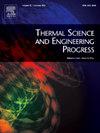Design and performance analysis of a curved channel liquid cooling system for battery thermal management
IF 5.1
3区 工程技术
Q2 ENERGY & FUELS
引用次数: 0
Abstract
Optimized thermal management is critical for ensuring the safety, longevity, and performance of lithium-ion battery packs, particularly in high-power applications. This study aims to improve thermal regulation by introducing a novel curved, multi-branch liquid cooling plate (LCP) design and implementing a multi-inlet architecture tailored for realistic battery modules. The thermal performance of these configurations was evaluated using computational fluid dynamics. Various cooling channel configurations were analyzed, including two-channel, four-channel, and multi-inlet LCPs, to assess their impact on temperature uniformity and heat dissipation efficiency. The results indicate that conventional two-channel LCPs provide adequate cooling at higher flow rates but fail to maintain uniform temperature distribution at lower velocities. The four-channel configuration improved thermal performance but still exhibited localized temperature variations. In contrast, the three-inlet cooling system significantly enhanced thermal uniformity, reducing temperature gradients and mitigating maximum temperature (Tmax) rise across all tested flow rates. Even at 0.1 m/s, the Tmax remained below 304 K, demonstrating the system’s ability to maintain safe operating conditions. Pressure drop analysis revealed that while increasing the number of cooling channels improves heat dissipation, it also raises flow resistance, highlighting the need for an optimized balance between thermal performance and pumping power. These findings contribute to the advancement of scalable and application-oriented battery thermal management systems for electric vehicles.
电池热管理弯曲通道液冷系统的设计与性能分析
优化的热管理对于确保锂离子电池组的安全性、寿命和性能至关重要,特别是在高功率应用中。本研究旨在通过引入一种新颖的弯曲、多分支液冷板(LCP)设计和实现针对实际电池模块量身定制的多入口架构来改善热调节。利用计算流体力学对这些结构的热性能进行了评估。分析了不同的散热通道配置,包括双通道、四通道和多入口lcp,以评估其对温度均匀性和散热效率的影响。结果表明,传统的双通道lcp在高流速下可以提供足够的冷却,但在低流速下不能保持均匀的温度分布。四通道结构改善了热性能,但仍然表现出局部温度变化。相比之下,三入口冷却系统显著提高了热均匀性,降低了温度梯度,并降低了所有测试流量下的最高温度(Tmax)上升。即使在0.1 m/s的速度下,Tmax也保持在304 K以下,这表明系统能够保持安全的运行条件。压降分析显示,虽然增加冷却通道的数量可以改善散热,但也会增加流动阻力,因此需要优化热性能和泵送功率之间的平衡。这些发现有助于电动汽车可扩展和面向应用的电池热管理系统的发展。
本文章由计算机程序翻译,如有差异,请以英文原文为准。
求助全文
约1分钟内获得全文
求助全文
来源期刊

Thermal Science and Engineering Progress
Chemical Engineering-Fluid Flow and Transfer Processes
CiteScore
7.20
自引率
10.40%
发文量
327
审稿时长
41 days
期刊介绍:
Thermal Science and Engineering Progress (TSEP) publishes original, high-quality research articles that span activities ranging from fundamental scientific research and discussion of the more controversial thermodynamic theories, to developments in thermal engineering that are in many instances examples of the way scientists and engineers are addressing the challenges facing a growing population – smart cities and global warming – maximising thermodynamic efficiencies and minimising all heat losses. It is intended that these will be of current relevance and interest to industry, academia and other practitioners. It is evident that many specialised journals in thermal and, to some extent, in fluid disciplines tend to focus on topics that can be classified as fundamental in nature, or are ‘applied’ and near-market. Thermal Science and Engineering Progress will bridge the gap between these two areas, allowing authors to make an easy choice, should they or a journal editor feel that their papers are ‘out of scope’ when considering other journals. The range of topics covered by Thermal Science and Engineering Progress addresses the rapid rate of development being made in thermal transfer processes as they affect traditional fields, and important growth in the topical research areas of aerospace, thermal biological and medical systems, electronics and nano-technologies, renewable energy systems, food production (including agriculture), and the need to minimise man-made thermal impacts on climate change. Review articles on appropriate topics for TSEP are encouraged, although until TSEP is fully established, these will be limited in number. Before submitting such articles, please contact one of the Editors, or a member of the Editorial Advisory Board with an outline of your proposal and your expertise in the area of your review.
 求助内容:
求助内容: 应助结果提醒方式:
应助结果提醒方式:


